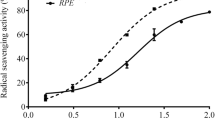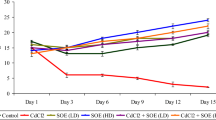Abstract
The hepatoprotective effect of onion and garlic extracts on cadmium (Cd)-induced oxidative damage in rats is reported. Control group received double-distilled water alone. Cd group was challenged with 3CdSO4·8H2O (as Cd; 1.5 mg/kg bw per day per oral) alone, while extract-treated groups were pretreated with varied doses of onion and/or garlic extract (0.5 and 1.0 ml/100 g bw per day per oral) for a week and thereafter co-treated with Cd (1.5 mg/kg bw per day per oral) for 3 weeks. Cd caused a marked (p < 0.001) increase in the levels of lipid peroxidation and glutathione S-transferase, whereas glutathione, superoxide dismutase, and catalase levels were decreased in the liver. We also observed a decrease in hepatic activities of alanine transaminase (ALT), aspartate transaminase (AST), and alkaline phosphatase and a concomitant increase in the plasma activities of ALT and AST. Onion and garlic extracts significantly attenuated these adverse effects of Cd. Onion extract proffered a dose-dependent hepatoprotection. Our study showed that Cd-induced oxidative damage in rat liver is amenable to attenuation by high dose of onion and moderate dose of garlic extracts possibly via reduced lipid peroxidation and enhanced antioxidant defense system that is insufficient to prevent and protect Cd-induced hepatotoxicity.








Similar content being viewed by others
References
Al-Khedhairy AA, Al-Rokayan SA, Al-Misned FA (2001) Cadmium toxicity and cell stress response. Sciences 1:39–43
World Health Organization (1992) Environmental health criteria 134, cadmium. International Programme on Chemical Safety (IPCS), Geneva
Shaikh ZA, Vu TT, Zaman K (1999) Oxidative stress as a mechanism of chronic cadmium-induced hepatotoxicity and renal toxicity and protection by antioxidants. Toxicol Appl Pharmacol 154:256–263
Nordberg GF (1984) Chelating agents and cadmium toxicity: problems and prospects. Environ Health Perspect 54:213–218
Augusti KT (1996) Therapeutic values of onion (Allium cepa L.) and garlic (Allium sativum L.). Indian J Exp Biol 34:634–640
Banerjee SK, Maulik SK (2002) Effect of garlic on cardiovascular disorders: a review. Nutr J 1:1–14
Griffiths G, Trueman L, Crowther T, Thomas B, Smith B (2002) Onions—a global benefit to health. Phytother Res 16:603–615
El-Demerdash FM, Yousef MI, Abou EI-Naga NI (2005) Biochemical study on the hypoglycemic effects of onion and garlic in alloxan-induced diabetic rats. Food Chem Toxicol 43:57–63
Denton L, Ojeifo IM (1990) Onion production practices and their improvement in Nigeria. Onion Newsl Trop 2:10–13
Lowry OH, Rosebrough NJ, Farr AL, Randall RJ (1951) Protein measurement with the Folin-phenol reagent. J Biol Chem 193:265–275
Beuge JA, Aust SD (1978) Microsomal lipid peroxidation. Methods Enzymol 52:302–310
Jollow DJ, Michell JR, Zampaglione N, Gillete J (1974) Bromobenzene-induced liver necrosis: protective role of glutathione and evidence for 3,4-bromobenzene oxide as the hepatotoxic metabolite. Pharmacology 11:151–169
Misra HP, Fridovich I (1972) The role of superoxide anion in the autooxidation of epinephrine and a simple assay for superoxide dismutase. J Biol Chem 247:3170–3175
Sinha KA (1971) Colorimetric assay of catalase. Anal Biochem 47:389–394
Habig WH, Pabst MJ, Jakoby WB (1974) The first enzymatic step in mercapturic acid formation. J Biol Chem 249:7130–7139
Reitman S, Frankel S (1957) A colorimetric method for the determination of serum glutamic oxaloacetic and glutamic pyruvic transaminases. Am J Clin Pathol 28:56–63
Jarup L (2002) Cadmium overload and toxicity. Nephrol Dial Transplant 17(Suppl 2):35–39
El-Demerdash FM, Yousef MI, Kedwany FS, Bahadadi HH (2004) Cadmium-induced changes in lipid peroxidation, blood hematology, biochemical parameters and semen quality of male rats: protective role of vitamin E and beta-carotene. Food Chem Toxicol 42:1563–1571
El-Sharaky AS, Newairy AA, Badreldeen MM, Eweda SM, Sheweita SA (2007) Protective role of selenium against renal toxicity induced by cadmium in rats. Toxicology 235(3):185–193
Newairy AA, El-Sharaky AS, Badreldeen MM, Eweda SM, Sheweita SA (2007) The hepatoprotective effects of selenium against cadmium toxicity in rats. Toxicology 242:23–30
Casalino E, Sblano C, Landriscina V, Calzaretti G, Landriscina C (2004) Rat liver glutathione S-transferase activity stimulation following acute cadmium or manganese intoxication. Toxicology 200:37–50
Ognjanovic B, Zikic RV, Stajn A, Saicic ZS, Kostic MM, Petrovic VM (1995) The effects of selenium on the antioxidant defense system in the liver of rats exposed to cadmium. Physiol Res 44:293–300
Ognjanovic BI, Markovic SD, Pavlovic SZ, Zikic RV, Stajn AS, Saicic ZS (2008) The effects of chronic cadmium exposure on antioxidant defense system in some tissues of rats: protective effect of selenium. Physiol Res 57:403–411
Singhal RK, Anderson ME, Meister A (1987) Glutathione, a first line of defense against cadmium toxicity. FASEB J 1:220–223
Sen CK (1997) Nutritional biochemistry of cellular glutathione. Nutr Biochem 8:660–676
Jinna RR, Ahanandsalim KJ, Desiough D (1989) Protection against cadmium toxicity and enzyme inhibition by dithiothreitol. Cell Biochem Funct 7:110–112
Casalino E, Calzaretti G, Sblano C, Landriscina C (2002) Molecular inhibitory mechanisms of antioxidant enzymes in rat liver and kidney by cadmium. Toxicology 179:37–50
Patra RC, Swarup D, Senapati SK (1999) Effects of cadmium on lipid peroxides and superoxide dismutase in hepatic, renal and testicular tissue of rats. Vet Hum Toxicol 41:65–67
Rana SV, Rekha S, Seema V (1996) Protective effects of few antioxidants on liver function in rats treated with cadmium and mercury. Indian J Exp Biol 34:177–179
Asagba SO, Adaikpoh MA, Kadiri H, Obi FO (2007) Influence of aqueous extract of Hibiscus sabdariffa L. petal on cadmium toxicity in rats. Biol Trace Elem Res 115:45–57
Navarro CM, Montilla PM, Martin A, Jimenez J, Utrilla PM (1993) Free radicals scavenger and antihepatotoxic activity of Rosmarinus. Plant Medicine 59:312–314
El-Demerdash FM, Elagamy EI (1999) Biological effects in Tilapia nilotica fish as indicators of pollution by cadmium and mercury. Int J Environ Health Res 9:143–156
Halliwell B, Gutteridge JMC (1999) Free radical biology and medicine, 3rd edn. Oxford University Press, Oxford
Kowalczyk E, Kopff A, Pijalkowski P et al (2003) Effect of anthocyanins on selected biochemical parameters in rats exposed to cadmium. Acta Biochem Polon 50:543–548
Murugavel P, Pari L (2007) Diallyl tetrasulfide modulates the cadmium-induced impairment of membrane bound enzymes in rats. J Basic Clin Physiol Pharmacol 18:37–48
Pari I, Murugavel P, Sitasawad SL, Kumar KS (2007) Cytoprotective and antioxidant role of diallyl tetrasulfide on cadmium-induced renal injury, an in-vivo and in-vitro study. Life Sci 880:650–658
Sidhu M, Sharma M, Bhatia M, Awasthi YC, Nath R (1993) Effect of chronic cadmium exposure on glutathione S-transferase and glutathione peroxidase activities in rhesus monkey: the role of selenium. Toxicology 83:203–213
Zikic RV, Stajn AS, Ognjanovic BI, Saicic ZS, Kostic MM, Pavlovic SZ, Petrovic VM (1998) The effect of cadmium and selenium on the antioxidant enzyme activities in rat heart. J Environ Pathol Toxicol Oncol 17:259–264
Whanger PD (2002) Selenocompounds in plants and animals and their biological significance. J Am Coll Nutr 21:223–232
Nuutila AM, Puuponen-Pimia R, Aarni M, Oksman-Caldentey K (2003) Comparison of antioxidant activities of onion and garlic and extracts by inhibition of lipid peroxidation and radical scavenging activity. Food Chem 81:485–493
El-Manakhly EM, Youssef SA, Hassieb MM (1998) The protective effect of garlic against carbon tetrachloride induced hepatotoxicosis in male rats. Some histopathologic and histochemical studies. Egypt J Comp Pathol Clin Pathol 11:35–45
Banerjeea SK, Maulika M, Manchandab SC, Dindac AK, Dasd TK, Maulika SK (2001) Garlic-induced alteration in rat liver and kidney morphology and associated changes in endogenous antioxidant status. Food Chem Toxicol 39:793–797
de Groot H, Rauen U (1998) Tissue injury by reactive oxygen species and the protective effect of flavonoids. Fundam Clin Pharmacol 12:249–255
Massadeh AM, Al-Safi SA, Momani IF, Alomary AA, Jaradat QM, Alkofahi AS (2007) Garlic (Allium sativum L.) as a potential antidote for cadmium and lead intoxication: cadmium and lead distribution and analysis in different mice organs. Biol Trace Elem Res 120:227–234
Morales AI, Vicente-Sanchez C, Jerkic M, Santiago JM, Sanchez-Gonzalez PD, Perez-Barriocanal F, Lopez-Novoa JM (2006) Effect of quercetin on metallothionein, nitric oxide synthases and cyclooxygenase-2 expression on experimental chronic cadmium nephrotoxicity in rats. Toxicol Appl Pharmacol 210:128–135
Guyonnet D, Siess MH, Le Bon AM, Suschetet M (1999) Modulation of phase II enzymes by organosulfur compounds from Allium vegetables in rat tissues. Toxicol Appl Pharmacol 154:50–58
Teyssier C, Amiot MJ, Mondy N, Auger J, Kahane R, Siess MH (2001) Effect of onion consumption by rats on hepatic drug metabolizing enzymes. Food Chem Toxicol 39:981–987
El-Shenawy SM, Hassan NS (2008) Comparative evaluation of the protective effect of selenium and garlic against liver and kidney damage induced by mercury chloride in the rats. Pharmacol Rep 60:199–208
Acknowledgments
The authors gratefully acknowledged the Department of Biochemistry, University of Ibadan, Ibadan, Nigeria for providing the basic facilities used in this study.
Author information
Authors and Affiliations
Corresponding author
Rights and permissions
About this article
Cite this article
Obioha, U.E., Suru, S.M., Ola-Mudathir, K.F. et al. Hepatoprotective Potentials of Onion and Garlic Extracts on Cadmium-Induced Oxidative Damage in Rats. Biol Trace Elem Res 129, 143–156 (2009). https://doi.org/10.1007/s12011-008-8276-7
Received:
Accepted:
Published:
Issue Date:
DOI: https://doi.org/10.1007/s12011-008-8276-7




